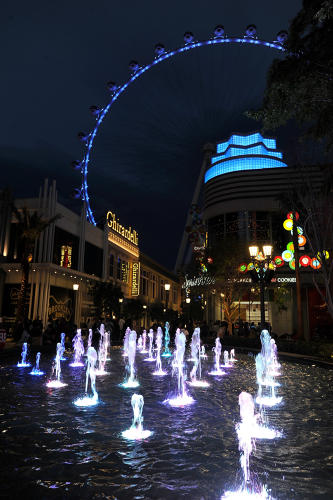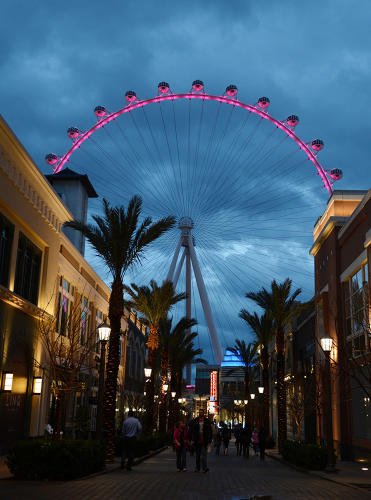The LINQ, a new outdoor shopping district in Vegas, is betting on the profitability of human-scale urban design.

COURTESY ERIK KABIK/ RETNA/ ERIKKABIK.COM
The most walkable place in Las Vegas may be a shopping mall. The LINQ, a new outdoor shopping and entertainment district located on the site of a former service alleyway and parking garage between the Flamingo Hotel and The Quad Resort, is specifically designed to appeal to pedestrians—a somewhat neglected contingent in Vegas.

COURTESY DENISE TRUSCELLO
Though downtown Las Vegas has gotten a recent spur in urbanist idealism in the form of Zappos founder Tony Hsieh’s Downtown Project, a $350 million endeavour to turn the neighbourhood into a vibrant, walkable innovation district only a few miles away, Las Vegas Boulevard is, in many ways, a poster child for anti-pedestrian urban design. The major thoroughfare is wide, and traffic is busy. The resorts are gargantuan and the distances between their set-back entrances vast—totally out-of-scale with humans. It’s not like people don’t walk there— a 2012 county study found “unacceptable” levels of pedestrian congestion on the sidewalks along the Strip—but there are few places truly designed to encourage it.
David M. Schwarz, the Washington, D.C.-based architect who designed the LINQ, says he’s “out to prove that Las Vegas can be a pedestrian-oriented place.”
“If you can create a much more commodious and interesting place to walk, people will,” he tells Co.Design. An estimated 20.4 million people pass by the 300,000-square-foot site each year, and Caesars Entertainment, the company that owns the LINQ as well as the neighbouring Flamingo and The Quad resorts, wants to appeal to younger customers. By 2015, 52% of visitor spending is expected to come from people between 21 and 46 years old, and a large portion of that age range has a track record of preferring urban centres.
From our partners:

DENISE TRUSCELLO
Along with David Codiga, the executive director of the LINQ, Schwarz and his team studied some of the best pedestrian street environments in the world—like Bourbon Street in New Orleans and Santa Monica’s Third Street Promenade—and thought about what makes them work.

DENISE TRUSCELLO
“One of the things that’s incredibly important to making place work well for pedestrians is scale,” Schwarz says. The size of the buildings, the doors, the windows, all were “very much geared towards the kinds of neighbourhoods people walk most comfortably in.” The buildings are intentionally modest—just one or two stories, made of brick and stone, without flashy facades and with patios on the upper floors.
To keep people walking, there are “weenies,” or objects of visual interest (term courtesy of Disney) every 400 feet or so, like plazas. From the LINQ’s entrance, you get a clear sightline of the 550-foot-tall High Roller, the world’s tallest Ferris wheel, to draw people in and get them to head through the shopping centre to the attraction, which is lit up by more than 2,000 LED lights.
[infobox]The buildings are intentionally modest – just one or two stories, made of brick and stone.[/infobox]“It feels comfortable to walk in,” Codiga says. “You don’t feel you’re being overwhelmed by some kind of Disney version of what life should be like.” The idea is, the more comfortable people feel, the longer they’ll stay. Walking down a street doesn’t feel like as big of a decision as going into a giant casino, so people may be more likely just to pop in. “I think people prefer a little less hard commitment,” Codiga says, and the LINQ creates an environment that feels like you could stop by and hang out, grab a cup of coffee and move on…but maybe you’ll stick around and shop, or maybe you’ll wander into one of the casinos next door. Any of those choices is a winning proposition for Caesars.

DENISE TRUSCELLO
And if the LINQ, which opened in late February, can prove that pedestrian-oriented design is good for business, more of Vegas may follow suit.
This article originally appeared in Fast Company.













